
An exceptional skeleton from a previously unknown dinosaur species on show at London’s Heathrow airport before being sold at auction in June
Heathrow Airport Terminal 5 exhibition – London -3 April to 3 June 2019

SKINNY, the Rolls-Royce of dinosaurs
He has been nicknamed SKINNY by palaeontologists; he is 150 million years old, and he is the latest wonderful dinosaur skeleton to be exhibited by renowned palaeontology expert Eric Mickeler.
This impressive cousin of the DIPLODOCUS still to be given a scientific name, is 13 metres long and 8 metres high (with his base) and will be on public display at HEATHROW AIRPORT (Terminal 5) from 3 April to 3 June before being sold at auction in France in June by auction house AGUTTES. He is estimated to be worth some 1.5 to 2 million euros, and a proportion of the sale proceeds will go towards a fund for protecting the great apes, in the same way as the sale of the Eiffel Tower theropod in June 2018 helped the Sea Shepherd and
The Cheetah Center environmental associations.
SKINNY has been studied by a scientific committee made up of several palaeontologists. They observed that he was a particularly well-preserved specimen, with over 90% of his original bones still present. He was compared with a Galeamopus, Diplodocus, Barosaurus, Kaatedocus and Supersaurus from the Morrison Formation Diplodocinae and with a Brontosaurus and Apatosaurus from the Morrison Formation Apatosaurinae, and then with a Amphicoelias and Suuwassea, without a corresponding species being identified. From the report, it is clear that Skinny is undoubtedly a diplodocid sauropod, belonging to a new Diplodocus genus.


Bones map, maps of the two profiles of SKINNY showing the authentic bones in red
A marvellous subject for scientific studies
In addition, he has the unique characteristic of presenting skin imprints; the tail that was discovered articulated is almost completely covered with skin, explaining the name chosen to identify him.
“This is the first time that such skin imprints have been found directly on skeletal elements in a sauropod. SKINNY is a marvellous subject for scientific studies because the presence of these ‘soft tissues’ constitutes the only direct evidence of what living dinosaurs actually looked like”, explains Eric Mickeler.

Skin fragments visible on SKINNY’s skeleton
A skeleton certified to be 90% complete
The DIPLODOCUS, and its cousins like Skinny, as well as the T-Rex , have always inspired enthusiasts to the point where these two dinosaurs continually compete for which of them has appeared in more animated films. It is the ultimate friendly giant.
“SKINNY is probably the most important Diplodocidae specimen to be discovered since the end of the 19th century. He is superior from a scientific point of view to the Diplodocus belonging to steel magnate and billionaire Andrew Carnegie, which is a composite dinosaur reconstructed from fragments of several specimens”, continues Eric Mickeler.
The interest and value of a dinosaur skeleton are determined by the specimen’s percentage of native bones, the fossilisation quality and the beauty of the skull. That is why Eric Mickeler always tries to ensure the traceability of the pieces he displays, providing a complete file: the excavation map indicating the records for each bone found and the assembled skeleton's osteological map, where it can be verified that each bone found at the dig site has been identified and correctly put back in place.
Eric Mickeler, an expert from the European Chamber of Expert-Advisors in Fine Art (C.E.C.O.A) and former Customs assessor, was one of the first to take the bold step of putting dinosaur skeletons up for auction, in particular at Christie’s, Sotheby’s and Aguttes. To ensure the transparency of this fast-developing market, Eric Mickeler has created the Eric Mickeler Fossile label, a trademark and quality certificate that guarantees that all the bones come from the same individual.
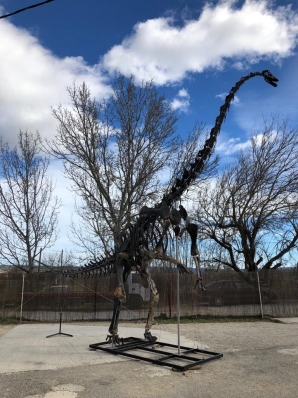
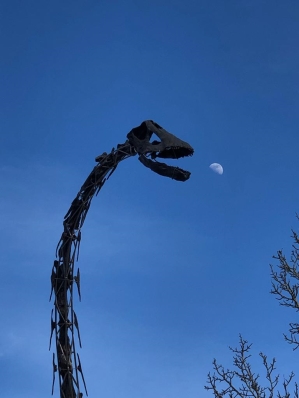
Exceptional Diplodocus skeleton with very rare skin imprints
Upper Jurassic (-157.3 to -152.1 million years old) - USA Morrison Formation
Height: 6.20 metres (8 metres with the base) – Length: 12.95 metres
An innovative structure for a modular display
Discovered in 2012 in Wyoming in the USA, this imposing skeleton is assembled on a stainless steel structure that is much more modern than traditional steel structures. Thanks to innovative technology developed, owned and fully mastered by the company Paleomoove Laboratory, the skeleton can be exhibited in various positions, enabling dynamic, modular staging.
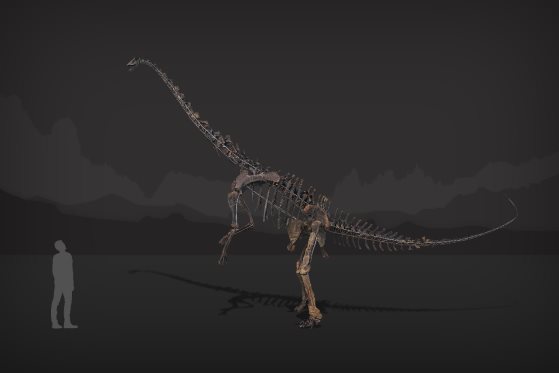
The popularity of the Diplodocus
The first Diplodocus fossil bone was discovered in 1877, and it was Othniel C. Marsh who coined the name Diplodocus in 1878. The first Diplodocus was assembled at the Carnegie Museum in April 1907, and although it belonged to the Carnegie steel magnate, it was only a composite construction of several scattered bones from partial Diplodocus skeletons. In any case, the novelty of this presentation, the gigantic size of the animal, as well as the communication skills of Carnegie, who had plaster copies of the dinosaur sent to all four corners of the Earth, earned the Diplodocus a place in the collective consciousness.
In addition to the Muséum national d'Histoire Naturelle in Paris, which received one of its most important pieces, the museums of London, Berlin, Vienna, Bologna, St. Petersburg, Madrid, Mexico and Buenos Aires all received a cast of the Diplodocus too.
History of major fossil auctions held by AGUTTES and their links with museums, industry and tourism
A new carnivorous dinosaur species and cousin of the Allosaurus sold for more than 2 million euros on 4 June 2018 at the Eiffel Tower to a financial fund. Studied and soon to be on display at the Royal Belgian Institute of Natural Sciences in Brussels.
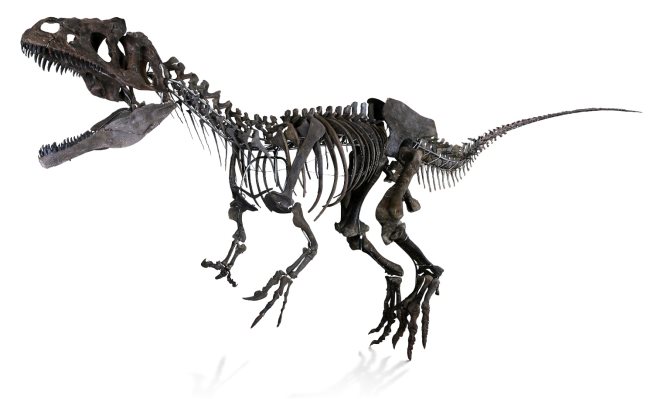
Kimmeridgian, Upper Jurassic (between 157 and 152 million years old)
Morrison formation, Wyoming, USA
Dimensions: Length: 8.70 metres tip to tip, approximately 9 metres uncoiled
Height: 2.60 metres Photo credit Aguttes
Allosaurus dinosaur skeleton sold by AGUTTES in Lyon for €1,128,000 on 10 December 2016 to KLEBER ROSSILLON, which manages historic sites such as the Caverne du Pont-d’Arc, reproducing the treasures of the Grotte Chauvet cave, the Museum of Montmartre and the Jardins suspendus de Marqueyssac in Dordogne, where this dinosaur skeleton was displayed.
Complete Allosaurus skeleton, USA
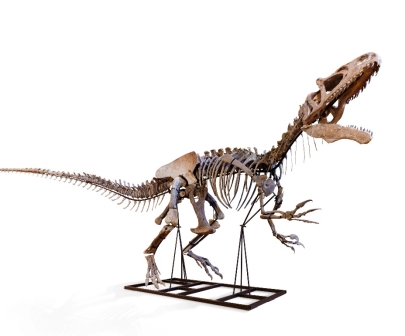
Mammoth skeleton sold by Aguttes in Lyon for €548,250 on 16 December 2017 to the Strasbourg-based company SOPREMA, a leader in the field of waterproofing products and owner of Mammouth-branded sealants, trademark.
Rare complete Mammoth skeleton, Mammuthus primigenius, Late Pleistocene, Siberia, Russia
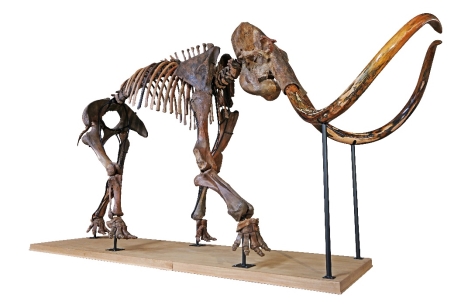
About Us
AGUTTES is the first independant auction house in France (without external shareholders) and was ranked as the fourth largest auction house in the French market in 2018. Founded by Claude Aguttes in 1974, the company holds 80 auctions per year with a team of 40. AGUTTES is also a major actor at Drouot in Paris, where it achieved the highest sale records in 2015, 2017 and 2018. In 2017, the auction house was chosen by the French Commercial Court to organize the sale of the tremendous Aristophil Collections of Rare Books and Manuscripts. In June 2018, AGUTTES reached a world record by selling a new carnivorous dinosaur species for more than 2 million euros at the Eiffel Tower. In 2019, the company opened a new sales representative office in Brussels and completed significant renovations in its saleroom in Lyon – the former train station of Brotteaux – which will allow new events to be created.
Contacts